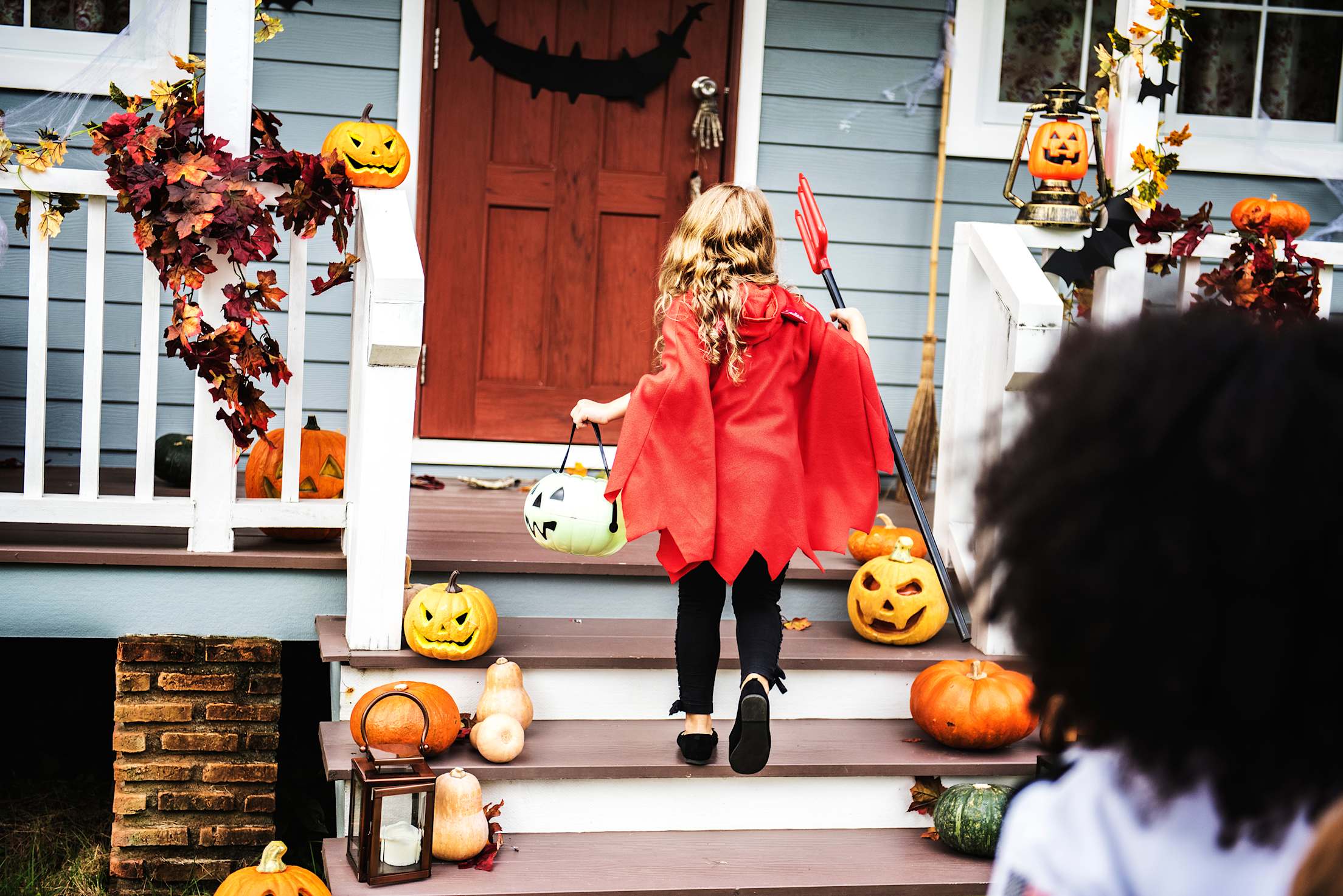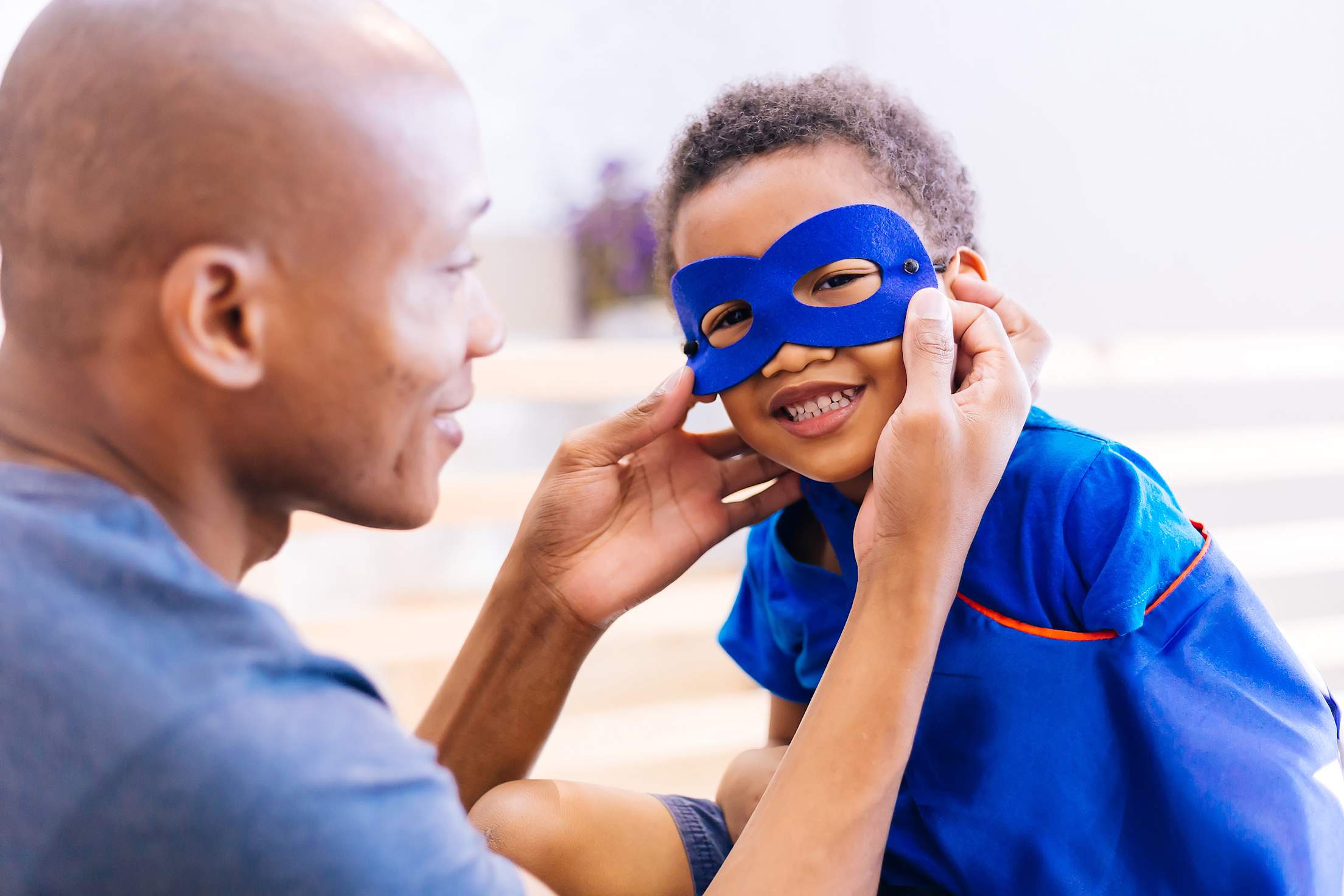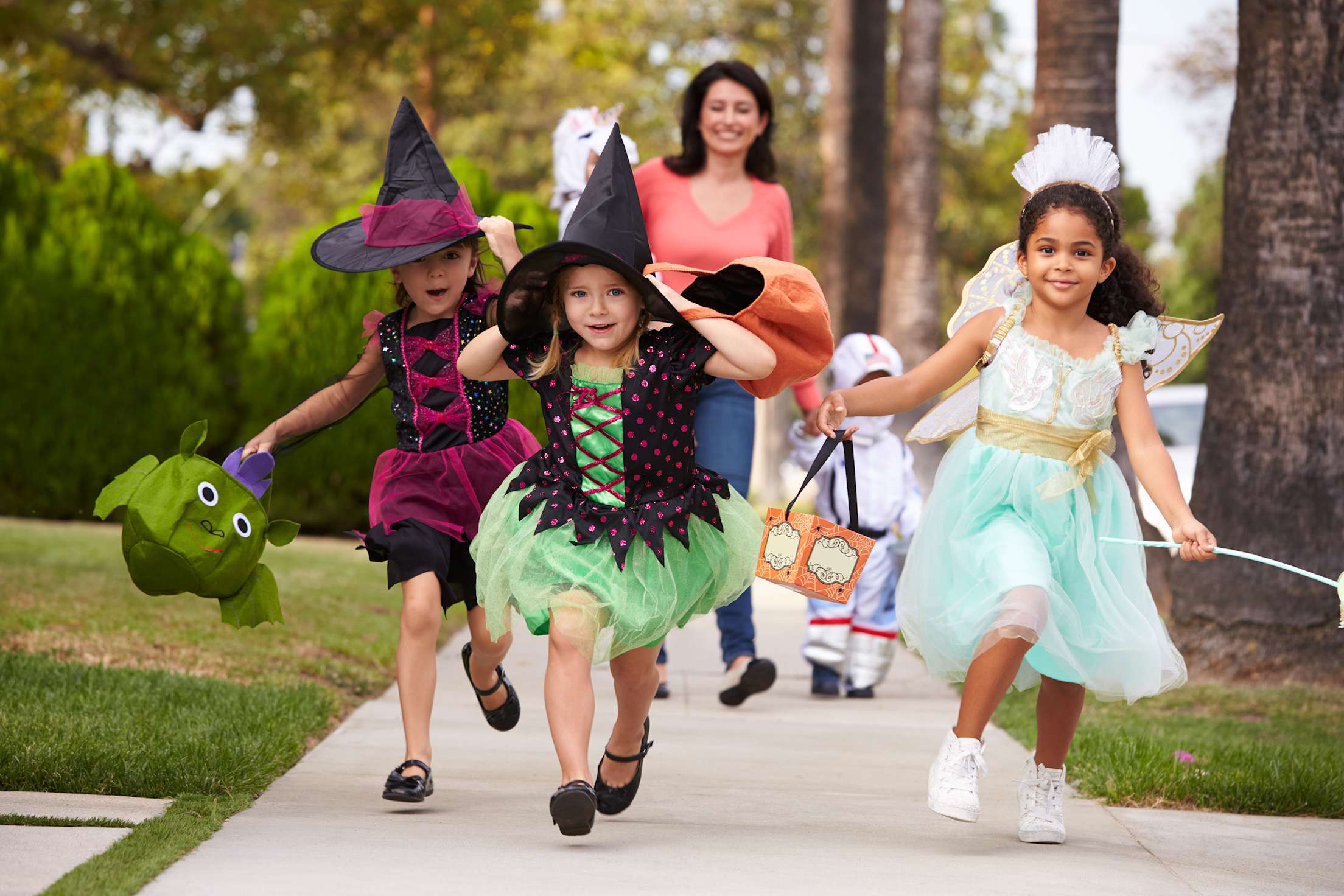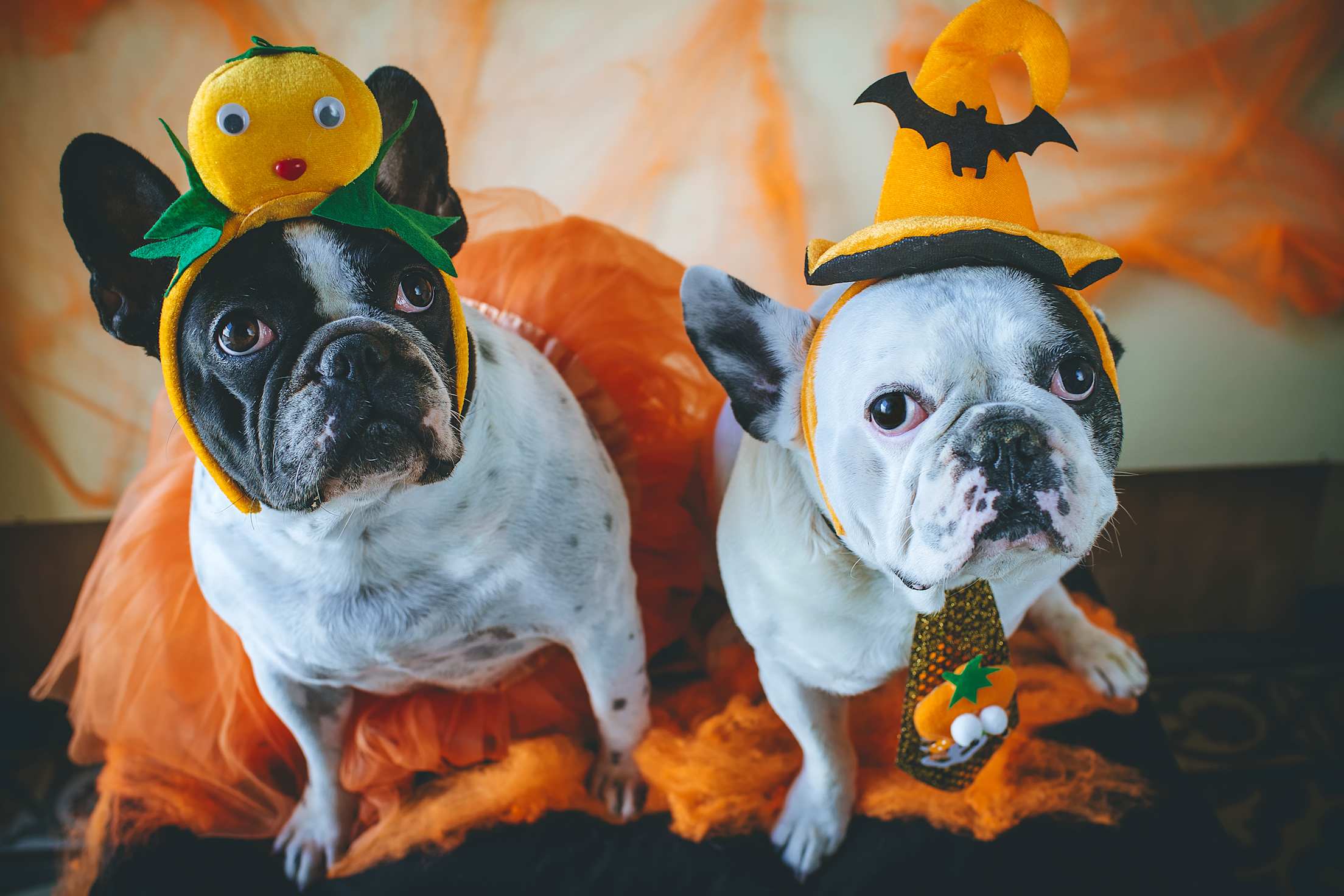
How to Have a Fun and Safe Halloween
This Halloween, it’s all treats, no tricks.

This Halloween, as you outfit your child—and yourself—in a delightfully frightful costume and put up ghoulish decorations around your home, take a moment to think about safety, too. From pumpkin-carving injuries to upset tummies from sugar overload to falls caused by ill-fitting costumes or vision-obscuring masks, Halloween can bring about both small and more serious accidents. Follow these simple tips to ensure that you and your little monsters have a spooky holiday, free from any real scares.
Encourage kid-friendly pumpkin-carving ideas.
A fearsome—or goofy—Jack-o’-Lantern is a true sign of the season. But sharp knives and small children are a dangerous combo. Follow these gourd-decorating safety tips:
Don’t let little ones use knives.
Instead, have young children draw a face on the pumpkin—then, an adult can do the carving before little hands scoop out the innards. Or go for entirely knife-free decorations: Paint your gourd or use stencils, googly eyes, and markers to create a masterpiece.
Cut with caution.
Carve pumpkins in a well-lit room and go slowly. There’s no prize for fastest pumpkin carver! Big kids and teenagers still require adult supervision—carving a pumpkin is more challenging than chopping vegetables, since it’s rounded, and has thick, hard-to-cut skin. If hands get wet with pumpkin guts, wash and dry them carefully before using the knife again to avoid slips. Serrated knives intended for pumpkin carving can also help keep hands safe and make the job easier.
Light your gourd safely.
The safest option is to provide illumination with a glow stick or flameless LED candle. But if you prefer the flicker of a flame, use a votive candle, put your pumpkin in a location where it won’t fall, and keep it far from curtains or other flammable materials. Only light your gourd when you’re home and can keep an eye on it.

Keep decor safe and make your home inviting.
Make your home’s decorations stand out—but also free from fire hazards, tripping opportunities, and other safety concerns—with these tips.
Encourage visitors.
Turn on your front lights and put up decorations to let trick-or-treaters know you’d like them to ring the bell.
Avoid flames.
Lining your stairs with candles can look atmospheric, but it’s also a tremendous fire hazard to any caped guests. Instead, opt for flameless, battery-operated candles or orange-and white-colored twinkle lights.
Don’t overload electrical outlets.
Do not daisy-chain extension cords, which can lead to overheating. Only use outdoor-rated decorations outside, and, in general, read instructions on any decorations (lights, inflatable objects, fog machines, etc.) carefully before using.
Remove tripping hazards.
You may get more traffic than usual on your lawn or front steps. If you have tricycles and toys strewn about, remove them so guests don’t accidentally tumble over them. Decorations can easily become a tripping hazard, too, so make sure to place them strategically and leave a clear, well-lit path for trick-or-treaters to approach your front door.
Consider offering alternative treats.
The neighborhood parents will appreciate you handing out a non-sugary treat. Still, no one craves raisins on Halloween and fruit is destined for the garbage, since parents will likely view it as a safety risk. Instead try handing out:
- Colored pencils, markers, or crayons
- A Halloween-themed puzzle (or small toys like bouncy balls, legos, bubbles, etc.)
- Festive temporary tattoos or stickers
- Spider—or other Halloween-themed—rings
- Glow-stick bracelets

Choose the right costume.
On a night where fairies and superheroes take over, make sure your child’s disguise follows these safety guidelines:
Make it visible.
If your child is a creature of the night clad mainly in dark colors, add reflective tape so they will be easily spotted. Tip: Place reflective tape on your child’s Halloween loot carrier, too.
Choose the right size.
Long hems, oversized masks, and ill-fitting shoes can all results in trips and falls. Make sure your child’s costume fits properly and is comfortable. You can use safety pins to tack up capes, skirts, and pants in a pinch.
Pay attention to flammability.
Long dresses and capes made out of synthetic fibers can quickly catch fire. Choose natural fibers when possible, and avoid oversized, draped costumes near any flames.
Avoid sharp accessories.
Your little pirate’s cutlass should be blunt and flexible. Follow that same rule for any accessory—like a cane, sword, or knife. Cardboard or bendy plastic is ideal here.
Conceal with care.
Masks and face paint can make the costume—just make sure your child’s mask or eyewear doesn’t obscure vision. Skip overly large hats and headpieces that can slip and obscure sight, too. And, when it comes to makeup, always opt for a nontoxic, lead-free option, and do a patch test (on your child’s arm, not face) a few days prior to Halloween. That way, you’ll know if your child is allergic. Don’t skip a thorough face cleaning at the end of the night to remove all traces of makeup too.
Avoid colored contact lenses.
Decorative contact lenses may complete the look, but they’re not worth the thrill. Using ill-fitting lens can result in eye damage (think: a scratched cornea, infection, etc.). If lenses are a must for a costume, visit an eye doctor for a prescription; this will ensure the lenses fit your eye properly. Purchase lenses only from an FDA-cleared vendor (not a costume shop) who will require a prescription.

Stay Safe While Trick-or-Treating
It’s the one day of the year when kids can safely accept candy from strangers! Here’s how to make sure your child’s trick-or-treating adventure goes off without a hitch:
Go as a group.
There’s no joy to trick-or-treating solo, so encourage your child to ring doorbells with a friend or a group. Parents should accompany young children. Stick to ringing doors on homes that invite trick-or-treaters with porch lights and Halloween decorations, and remind your child never to go inside a stranger’s home, even on a night like Halloween, when some typical rules are suspended.
Walk safely.
Bring along flashlights, and have your child follow the usual pedestrian safety rules: use the crosswalk, look both ways before crossing, and avoid dark or deserted streets.
Use reflective tape.
Attach reflective tape on costumes and your child’s Halloween bucket to make sure motorists can spot your child. Carry flashlights to illuminate the sidewalk and increase your ghostly glow (and visibility).
Dress warmly.
Halloween can be a chilly night. To avoid a bulky coat obscuring your child’s costume, try layers: long underwear, high wool socks, and a sweatshirt under festive garb will help her keep warm.
Eat treats at home—but not too many.
Let the anticipation grow when it comes to the treats—have your child hold off on sampling candy until the end of the evening, when you can inspect it in the light for open wrappers or signs of tampering. Discard anything suspect, along with homemade treats. If you have young children, remove choking hazards, such as gum or hard candies, too.
Indulging in sweets on Halloween is part of the joy of the holiday. Still, you don’t want to go overboard, or make it a month-long bad habit. Before you head out on your trick-or-treating adventure, settle on how many pieces of candy your child can indulge in at the end of the evening.
Smart Tip: After Halloween, if the pile of candy bounty is staggering, find a nearby Halloween candy buyback program and let your kids turn in their loot for money or other goods.

Don’t Forget About Pets
For pets, Halloween can be a confusing surprise, full of incessant doorbell ringing, poisonous treats, and uncomfortable costumes. Follow these tips to make sure dogs and cats stay safe this Halloween:
Be smart about costumes.
Pet costumes can be hilarious and adorable, but aren’t always comfortable. If you dress up your cat or dog, make sure the costume fits and doesn’t cover eyes, ears, or mouth. Watch for parts that your pet may chew on, or that could be a choking hazard, and if Fido or Fluffy seems uncomfortable or unhappy, take off the costume.
Put candy out of reach.
Don’t let pets get into the Halloween treat stash. Any candy is problematic for pets, but chocolate and xylitol, a sugar substitute, are particularly bad news.
Keep pets secure inside.
A frequently opened door makes it easy for pets to wander outside. Your best bet is to keep dogs and cats in a room with a closed door during trick-or-treating hours. This is a favor to your guests, too—some small children might find cats or dogs frightening.